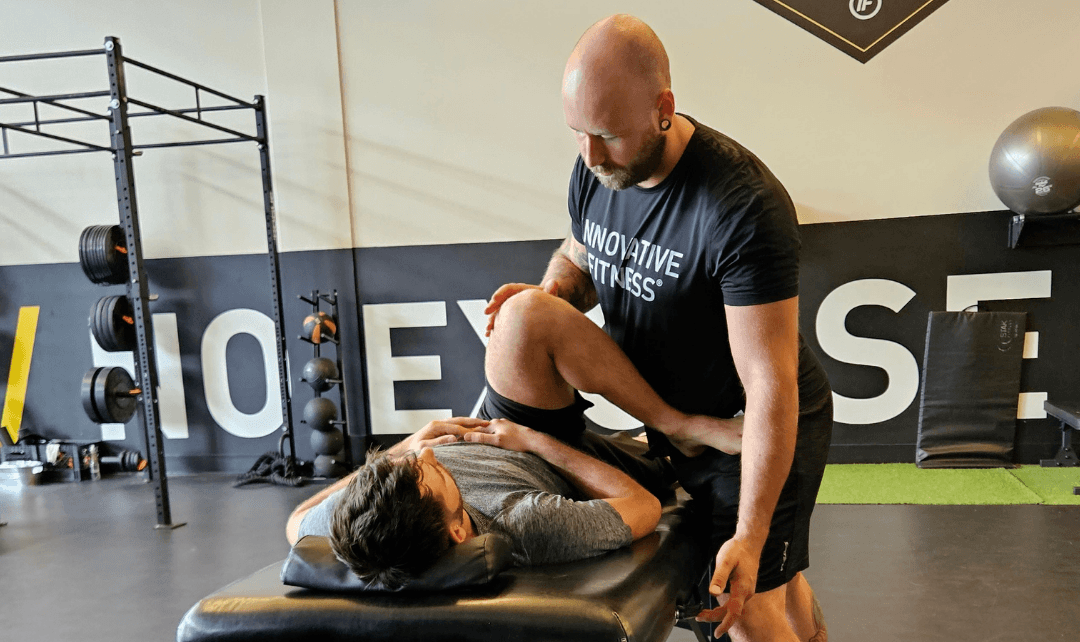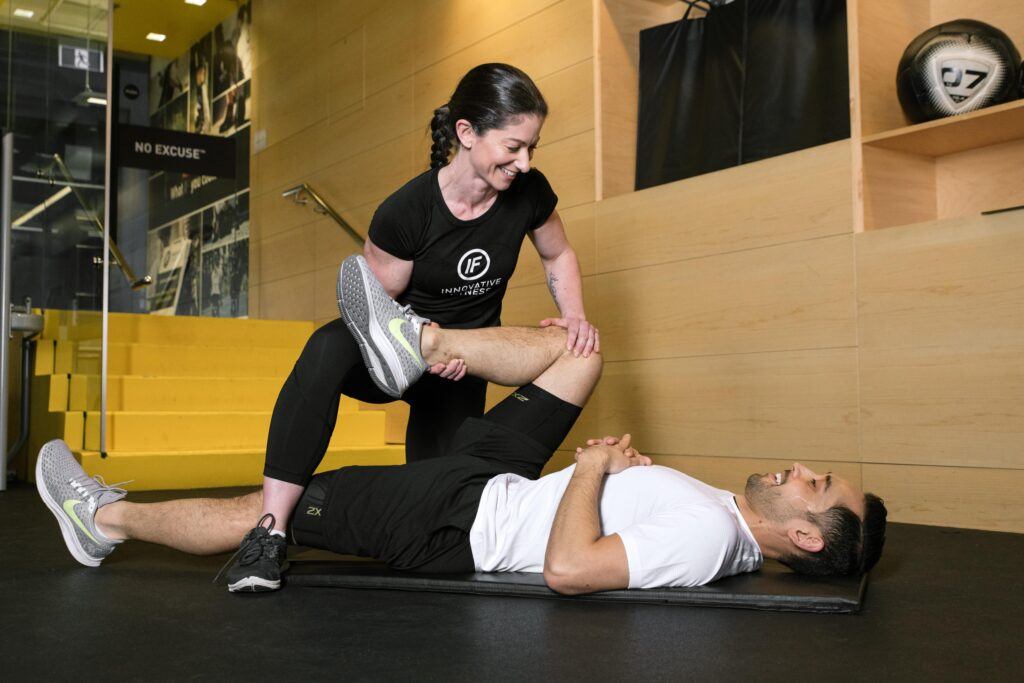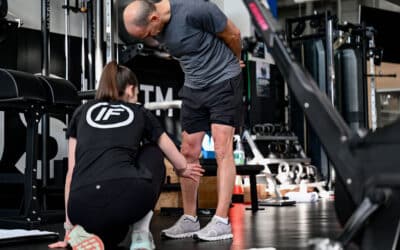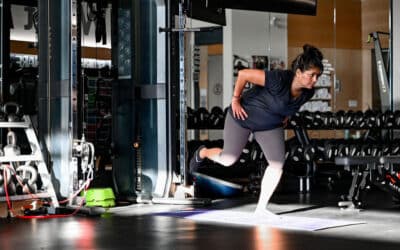Taking your body back home: The Comprehensive Guide to Fascial Stretch Therapy
In the pursuit of optimal health and fitness, people often explore various avenues to enhance their well-being. One such effective and science-backed form of bodywork called Fascial Stretch Therapy (FST) is rapidly gaining popularity—and for good reason. This innovative stretching technique delivers truly impressive results, and best of all, feels amazing while you’re doing it. Clients can experience significant improvements in flexibility, pain relief, and mobility in just 5 or 10 minutes of treatment, with long-lasting effects.
At Innovative Fitness, we understand the importance of holistic wellness and are proud to have FST as a key offering in our recovery and performance services.
What is Fascia?
Fascia is a continuous, multidimensional network of connective tissue that wraps around and permeates every muscle, bone, organ, and nerve fiber in the body. Often described as the body’s “scaffolding” or “organ of structure,” fascia provides support and stability while allowing for smooth, unrestricted movement. Think of it like a highly organized, tension-balancing system that holds everything in place.
Beyond its structural role, fascia plays a crucial role in movement mechanics, force transmission, and even pain perception. However, fascia can become dense, dehydrated, and restricted due to injury, poor posture, stress, or repetitive movements. These restrictions can lead to chronic discomfort, muscular imbalances, and mobility limitations, making fascial care essential for long-term physical health.
What are “fascial lines”?
In Thomas Myers’ groundbreaking book “Anatomy Trains,” he introduces the concept of fascial lines, revolutionizing our understanding of human anatomy and movement. Fascial lines are interconnected networks of connective tissue that span the entire body, influencing how we move and function. These interconnected pathways of connective tissue span the entire body, influencing how we move and function.
Some key fascial meridians include:
- Superficial Back Line: Runs from the bottom of the feet, along the back, to the skull.
- Superficial Front Line: Connects the front of the body from toes to head.
- Lateral Line: Stabilizes side-to-side movement and balance.
- Spiral Line: Wraps around the body in a corkscrew-like pattern, supporting rotation and functional movement.
- Deep Front Line: Serves as the body’s deep stabilizing core, linking the pelvis, rib cage, and diaphragm.
By understanding these fascial connections, we can improve movement efficiency, posture, and overall athletic performance.
Why does taking care of our fascia matter?
Fascia plays an active role in flexibility, stability, and injury prevention. In a healthy state, fascia is hydrated, pliable, and able to adapt to movement demands. However, factors like physical trauma, stress, sedentary behavior, and repetitive motion can cause it to become tight and immobile, leading to chronic pain, postural issues, and inefficient movement patterns.
Restricted fascia can place excessive tension on muscles and joints, contributing to:
- Chronic pain, stiffness, and reduced range of motion
- Postural misalignment and muscular imbalances
- Increased susceptibility to injury
By incorporating fascial stretching and manual therapy, we can restore movement efficiency, improve recovery, and optimize performance.
What is Fascial Stretch Therapy (FST)?
It is a highly specialized, science-driven stretching system that focuses on enhancing mobility by targeting both fascia and joint capsules. Unlike traditional stretching or deep tissue massage, FST integrates active movement, traction, and oscillation to create lasting improvements in mobility and flexibility.
During an FST session, a trained practitioner will guide your body through dynamic, assisted stretching techniques, using controlled breathwork and gentle resistance to:
- Release fascial adhesions and restore tissue elasticity
- Improve mobility, range of motion, and neuromuscular coordination
- Reduce pain and stiffness caused by tight fascia
- Enhance athletic performance and recovery by optimizing biomechanics
Unlike deep tissue massage, FST is pain-free, deeply relaxing, and tailored to your individual needs, making it ideal for both active individuals and those recovering from injury.
Benefits of Fascial Stretch Therapy:
- Improved Flexibility: FST focuses on lengthening and restoring the natural elasticity of the fascia, leading to increased flexibility and range of motion.
- Pain Reduction: By releasing tension in the fascia, FST can help alleviate chronic pain, stiffness, and discomfort associated with various conditions, including muscle imbalances and postural issues.
- Enhanced Performance: Athletes and fitness enthusiasts can benefit from FST to optimize their physical performance by improving muscle function and reducing the risk of injuries.
- Stress Reduction: FST incorporates gentle, rhythmic movements and controlled breath, promoting relaxation and reducing stress. This can contribute to improved mental well-being and a better overall sense of calm, due to the down regulation of the nervous system from fight or flight (Sympathetic) to rest and recover mode (parasympathetic).
Fascial stretch therapy as a joint care system:
One key advantage of Fascial Stretch Therapy is its ability to promote long-term joint health and function.
✔ Enhances joint mobility and reduces stiffness
✔ Increases circulation and nutrient delivery to joint tissues
✔ Optimizes biomechanics to decrease joint stress and wear
✔ Supports injury prevention and longevity in active individuals
By incorporating FST into a regular movement routine, clients can maintain pain-free movement, reduce the risk of joint degeneration, and improve overall mobility as they age.
Who Can Benefit from Fascial Stretch Therapy?
FST is beneficial for individuals across all activity levels, including:
- Athletes aiming to improve movement efficiency and recovery
- Individuals managing chronic pain or recovering from injury
- Anyone looking to improve flexibility, posture, and movement quality
At Innovative Fitness, we believe in cutting-edge movement therapies to support your health and fitness journey. Fascial Stretch Therapy is a cornerstone of our holistic approach—helping you move better, feel better, and live pain-free.
Book Your Fascial Stretch Therapy Session Today!
Ready to experience the benefits of Fascial Stretch Therapy? Book a session with our expert FST practitioners at Innovative Fitness and take the next step toward optimal mobility and performance.







